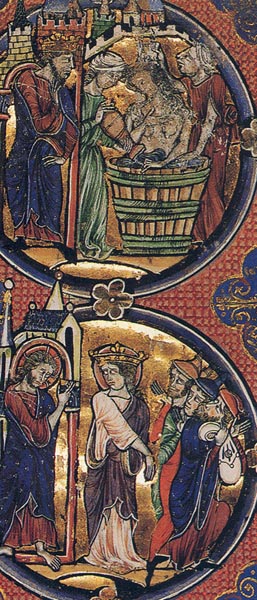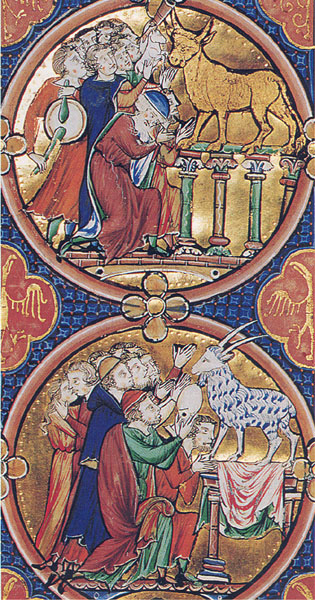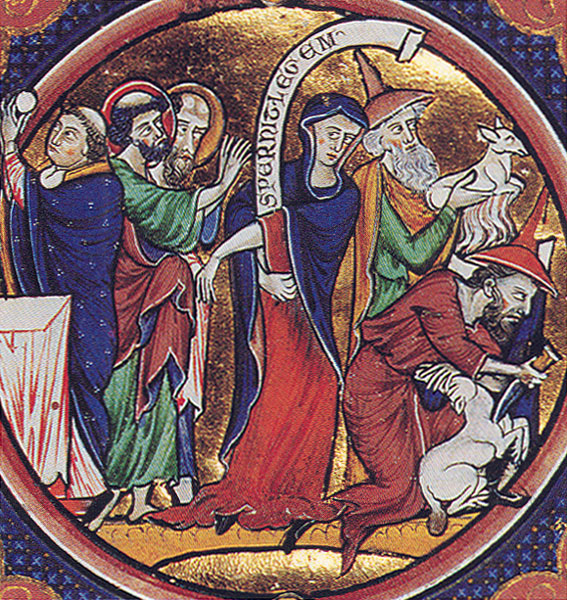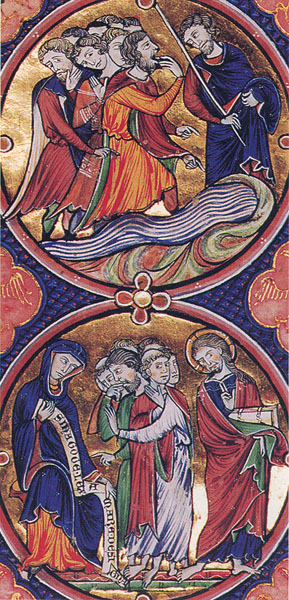The Un-Moralized Bible


Sometime around the year 1225, a Latin Bible with illustrated commentary was made for King Louis VIII of France.1 It is called the Bible moralisée, and it is a remarkable and disturbing work.
This Bible is massive both in size and scope. Every one of its 246 pages is coated in gold. Each page contains four passages from the Bible, divided into two vertical columns. The manuscript includes passages from the Old Testament books of Genesis, Exodus, Leviticus, Numbers, Deuteronomy, Joshua, Judges, Samuel, Kings, Esdras, Job, Daniel, Tobit, Judith, Esther and Maccabees, and the New Testament Apocalypse of John. (The books of Esdras, Tobit, Judith and Maccabees are included in the Catholic canon, although they do not appear in the Hebrew Bible and are considered apocryphal in Protestant tradition.) Below each of the biblical passages (which are actually paraphrases rather than exact quotations of Scripture) is a commentary explaining the meaning or significance of the biblical text. Both the biblical excerpts and the commentaries are brief. The bulk of the page is taken up by illustrations contained within circular frameworks, or roundels, immediately to the right of each of the two columns of text. Though clearly created by educated clerics, it is more an edifying picture book than a scholarly text.
The illustrations do not only depict biblical scenes, however. They illustrate the commentary, too. These illustrations are among the very few medieval illuminations that self-consciously depict contemporary (that is, medieval) figures and situations. The nature of the commentary, too, is unusual. Most medieval exegetical works interpret scenes from the Hebrew Bible, or Old Testament, as “signs” for—parallels to or predictions of—New Testament events. This manuscript, however, is different. It reads biblical events as foreshadowing contemporary social situations, yielding pertinent moral instruction—hence its name, which is French for the Moralized Bible.
The Moralized Bible is unusual in another respect. An inordinate number of its illustrations are vehemently anti-Jewish: In picture after picture, Jews are shown attacking Christian saints, threatening Christian clerics, engaging in obscene acts with animals, making offerings to idols or worshiping the devil.2


To find evidence of the hatred of Jews in a medieval Christian work hardly seems surprising. At the time this manuscript was created, the Jewish community of France faced a series of unprecedented and portentous developments. Between 1182 and 1198, Jews were barred from residing in Paris or its environs; this was the first known expulsion of Jews from any large territory in medieval Europe. In 1192, for the first time, a king of France personally and violently attacked a Jewish community, burning many Jews from a town called Brie, in Champagne, for allegedly murdering a Christian, although no body was ever found. In 1215, again for the first time, Jews living in Christendom were ordered to wear distinctive clothing.a And in 1223, the French crown initiated the economic decline of the Jewish community by withdrawing its longstanding protection of Jewish moneylending.3
Yet this hardly explains the unique depictions in the Moralized Bible, which, after all, was made by and for Christians living in an overwhelmingly Christian kingdom; Jews were a tiny minority in this society. They had no political power and, contrary to stereotype, were not a significant economic force. Moreover, Jews had not figured particularly prominently either in Christian theological writings or in Christian art up to this point, and—with a few famous exceptions—the few visual and literary references that did exist tended to be fairly routine and standardized.4 The anti-Jewish imagery of the Moralized Bible was, to say the least, innovative.
Many of the commentaries in the Moralized Bible use scriptural villains to refer to contemporary “sinners” or “bad people.” For instance, the Philistines who rejoiced at the death of the prophet Samuel (1 Samuel 25:1) become in the commentary text “infidels and enemies of God” rejoicing at the death of a good medieval prelate (see photo of roundels, top of article). Throughout the manuscript, however, these contemporary sinners are illustrated by figures displaying the traditional high Gothic artistic attributes of Jews: pointed hats and beards.5 (Not that medieval Jews actually wore pointed hats or that Jewish males were inevitably bearded. To the contrary, medieval texts—most notably the 1215 church canon imposing distinguishing clothing on Jews—suggest that Jews were not visually distinct from Christians.) In the commentary illustration for 1 Samuel 25:1, those infidels and enemies are portrayed as a group of Jews whispering and gesturing irreverently beside the body of a bishop laid out for burial.
Several themes dominate the commentary texts and illuminations. The first is probably the most expected: a diatribe against the greed and economic activities of the Jews. The moneybag is the most common visual symbol associated with Jews in the Moralized Bible, and usury the most frequently censured activity. (Usury was generally defined in the high Middle Ages as the lending of money at interest, regardless of the rate.) In the commentary on the story of Cain and Abel, in which Abel’s offering is accepted and Cain’s offering is rejected (Genesis 4:3–5), Cain is said to signify “the Jews, who make offering of their usuries and greed.” Cain is depicted as three Jews, one holding a bowl of money and one holding a frog, a symbol of usury. Similarly in the explication of Leviticus 11:15, in which God tells Moses to curse the raven and other unclean birds, the raven is said to represent usurers. In the roundel, the raven is represented as a Jew hiding moneybags within his hood (see representative page from the Moralized Bible, top left).
Many Jews did indeed practice lending at interest, but most did not.6 Moreover, in early-13th-century France, Christians as well as Jews practiced usury—and with impunity. Indeed, the texts and images of the Moralized Bible concede as much. For example, the commentary to Leviticus 22:19 stipulates that pious donations tainted by usury, greed and simony (the buying of church office) must be rejected—a directive that would be applicable only to Christian usurers. Jews were hardly in the habit of making donations to the church or buying ecclesiastical positions. Many commentary texts in the Moralized Bible call for the excommunication of Christian usurers. The illustrations even depict moneylending clerics gleefully counting their coins (see photo, below).

So the stereotyping of Jews as usurers is more complex than it might at first seem: It must be considered a polemical device rather than a reflection of “real” facts or even universal attitudes. This stereotype of Jews was intensified and solidified because contemporary Christian activities and assumptions were not exactly what the moralists thought they should be.
In the commentaries money is associated with sin, and in the roundels sin is often represented as a moneybag associated with the Jews. Metaphorically, money becomes linked to idolatry, devil worship and the Antichrist—all represented by Jews. This broadening of the concept of money is seen in the manuscript’s treatment of the text in which Bathsheba is seen bathing (2 Samuel 11:2). In the commentary, Bathsheba is said to symbolize the Holy Church cleansing herself of “dirty sinners.” Although presumably a stain on the body of the church would be a Christian blemish, the “dirt” in question is concretized as money—filthy lucre. The accompanying roundel portrays this concretization of “dirty sinners” as Jews holding a moneybag (see pair of roundels, below).

A still more virulent image based on economic polemic arises from the interpretation of the golden calf episode (Exodus 32). The commentary to this episode explains that the Hebrews who made the golden calf signify “those who adore the devil and believe in him.” In the adjacent roundel a man and a woman embrace, symbolizing the sin of lust, while various figures kneel and worship a goat on a pedestal (see photo, above). Most of the worshipers are bareheaded and can easily be taken for Christians. But one is bearded and wears a pointed hat—a Jew. It is he who offers the goat demon a bag of money, symbolizing greed, and it is he who leads this crowd of devil worshipers. In this way the Moralized Bible creates and harnesses new perceptions about money in general and usury in particular to generate loathing for what was, after all, a widespread economic practice. And Jews were caught in the crossfire.

Another theme of the Moralized Bible revolves around Jewish law and ritual. The standard argument is that Jews obsess about the letter (or “flesh”) of the law and neglect the spirit of Scripture. This has led them to deny Jesus Christ and misunderstand the word of God. The Jewish adherence to Levitical dietary regulations and rabbinical rituals serves only to demonstrate their utter failure to realize that the coming of Jesus Christ ended the reign of the law and ushered in a new period of grace. This argument is common in medieval Christian discussions of Judaism.b But, as was the case for economic polemic in the Moralized Bible, this standard, abstract theology also takes on vivid and concrete symbolism in this unusual medieval manuscript. Signs of the law such as scrolls and sacrificial animals symbolize the Jews’ wrongheaded practices, which can only lead to “carnality” and “materiality.” And this “materiality” brings us right back to those other vivid and recurring themes about Jews: greed, idolatry and devil worship.


The Moralized Bible also adds an unusual twist to its indictment of Jewish learning: The Jews’ literalism is attributed to their insatiable intellectual curiosity and their love of philosophy and other “secular” studies. Symbols initially developed to represent Jewish law, such as the calf offering, are now broadened to condemn other Jewish values. A calf offering and a devil, for example, appear in a roundel condemning Jewish philosophy (see first illustration from the Moralized Bible), while a calf offering and kosher slaughtering are paired in a roundel castigating Jews for rebuffing Christian preachers (see photo, above). A female personification of Judaism holds a scroll of the law to illustrate a text warning of the dangers of “secular studies,” which in this context refers to the relatively new and professionally lucrative university fields of astronomy and dialectic (see bottom roundel, below). In the aggregate, these images connect Jewish “carnality” and “materiality” to the full range of their intellectual pursuits, suggesting that their inability or unwillingness to think, read or act on a spiritual level underlies their fascination with philosophy, their affinity for secular knowledge and their hostility to the church.

A new and somewhat startling symbol further expands this polemical repertoire: a cat. In a roundel denouncing “evil” and “deceiving” philosophers, these savants are linked with greed and infidelity through the depiction of an idol presiding over a philosophy study group (see large roundel, above). The figure in the forefront of the lesson is recognizable by his hat and beard as a Jew. But a new detail is added to this anti-Jewish representation: The figure is holding a domestic cat and kissing it on the mouth! A similar image slightly later in the manuscript depicts a member of a group of “deceiving Jews, heretics, and evil philosophers” kneeling and paying homage to a cat while an idol leers down on the proceedings (see small roundel, above). Strange as these images are—and they have no known parallels elsewhere in medieval art—they are replicated in no fewer than 14 roundels in the manuscript. Cats are cradled in the arms of Jews, “infidels” and “heretics”; they are worshiped and adored, and more than a few times they are kissed—on the mouth or, most strikingly, on the anus (see roundel above, right).
This last and weirdest image actually illuminates the meaning of the symbol. Religious polemics at this time alleged that heretics conjured the devil in the form of a cat and bestowed upon his anus an “obscene kiss.” In France heresy charges like this proliferated in the years 1190 to 1250, as Catholic clerics became ever more concerned about Christian schism and dissent, both within the University of Paris, which was the center of orthodox theology and where the creators of the manuscript almost certainly studied, and in wider lay society. The sign of the cat thus identifies the Jews with Christian renegades and reinforces the interweaving of anti-Jewish polemic with internal Christian concerns (just as we saw earlier regarding usury), for the majority of cats appear with heretics, not with Jews at all.
Through such overlapping and shifting of symbols and contexts, the iconography of the Moralized Bible carefully constructs a dense and complex argument. It seems to assert that new secular subjects being taught at the University of Paris were leading overly curious students to error and dragging Christendom into secularism and materialism—in short, into iniquitous Jewish ways. Thus, Judaism with all its faults—avarice, skepticism, literalism—is not other and alien, but rather seductive and infectious, and, for this, all the more dangerous.
To understand the anti-Jewish polemic in the Moralized Bible, the attitude toward Jews must always be put in its broader context. Anti-Judaism is part of majority rather than minority history. How Jews were viewed and represented—the characteristics traditionally attributed to them and the features newly imposed on them—cannot be divorced from internal Christian developments. We have seen that familiar signs and symbols can come to convey new and unfamiliar messages, reflecting contemporary concerns. The images we have looked at suggest that in the early 13th century Jews were not seen as the opposite of or as the other to Christians. Rather, they testify to the fact—and the fear—that Christian society in the 13th century was increasingly taking on actual and stereotypical Jewish traits.
The urban northern French society out of which the Moralized Bible sprung underwent rapid and unprecedented economic expansion and political consolidation in the late 12th and early 13th centuries. Heterodoxy was proliferating; new non-Christian works were infiltrating the university curriculum; and the economy was becoming increasingly money oriented. Moneylending was being practiced with impunity by Christians as well as by Jews, and kings and princes were profiting from it. If these developments came to be associated with Jews, it was not just because Jews were traditional scapegoats for Christianity, but because the specific ways in which society was changing—becoming wealthier, more urbanized, more secular, more literate, more curious—entailed the spread of qualities long labeled “Jewish.”
The Moralized Bible decried such developments, but it could not arrest them. It is ironic that the anti-Jewish polemic in the Moralized Bible both succeeded beyond its wildest dreams and utterly failed. On the one hand, its conceptual and rhetorical innovations—the translation of theological abstractions into immediate social terms—helped pave the way for later repression. By the end of the Middle Ages, Jews were expelled from France and from most regions in western Christendom. The traits Jews represented, however—commerce, criticism, curiosity and dissent—not only remained, but became the dominant characteristics of modern European society.
MLA Citation
Footnotes
Although not specified in the 1215 edict, the French would soon require a circle to be sewn onto Jews’ clothing, while the English required a badge in the shape of tablets. Later in the 13th century, Germany imposed a “traditional” Jewish hat—which seemed to derive from art rather than the other way around.
The stimulating and provocative rereading of Paul offered by John G. Gager in “Paul’s Contradictions: Can They Be Resolved?” BR 14:06, was not shared by medieval Christian exegetes.
Endnotes
For a fuller examination of the themes discussed in this article, see my recent book: Sara Lipton, Images of Intolerance: The Representation of Jews and Judaism in the Bible moralisée (Berkeley, CA: Univ. of California Press, 1999).
For these events, see William Chester Jordan, The French Monarchy and the Jews: From Philip Augustus to the Last Capetians (Philadelphia, PA: Univ. of Pennsylvania Press, 1989); or Robert Chazan, Medieval Jewry in Northern France (Baltimore, MD: Johns Hopkins Univ. Press, 1973).
An excellent recent discussion of Jews in medieval Christian thought is Jeremy Cohen, Living Letters of the Law (Berkeley, CA: Univ. of California Press, 1999). For population estimates, which range between .05 and 5 percent of the population, see Jordan, The French Monarchy, pp. 5–10.
See chap. 1 of Lipton, Images of Intolerance; and Ruth Mellinkoff, Outcasts: Signs of Otherness in Northern European Art of the Later Middle Ages, 2 vols. (Berkeley, CA: Univ. of California Press, 1993).
